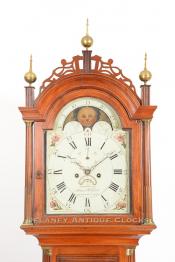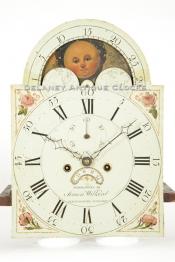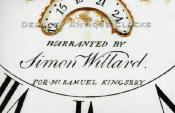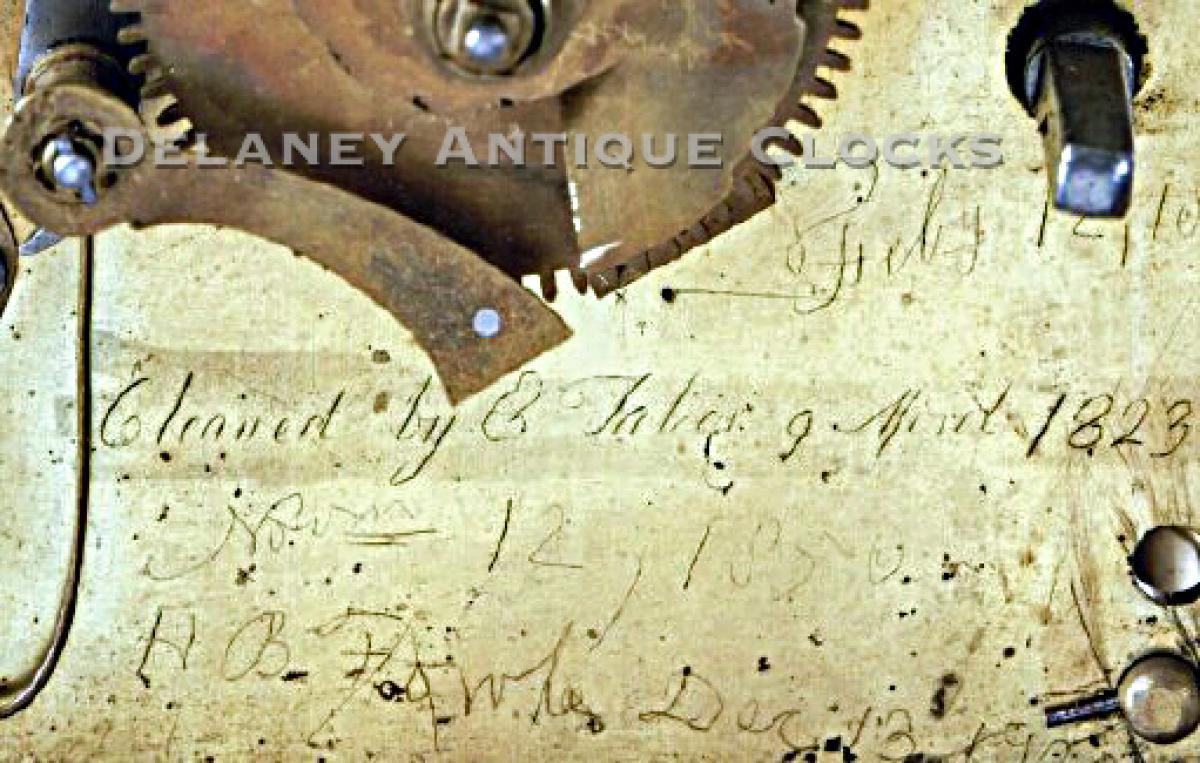Warranted by Simon Willard for Mr. Samuel Kingsbry. Tall case clock with quarter fan inlays. VV-107.
This is a very good example. This mahogany case exhibits excellent proportions and is decorated with line inlays and quarter fans. The case stands on four ogee bracket feet. These are applied to the base section under the double-step molding. The base panel is formatted in a horizontal position. The line inlay pattern follows the shape of the base. Each of the four corners is fitted with a decorative quarter fan comprised of five individual petals. These petals are individually shaded. The waist is long and narrow and fitted with a large rectangular-shaped waist door. This door is trimmed with applied molding and features the same inlay pattern exhibited in the base. Brass-stopped fluted quarter columns flank the sides of the case. These terminate in brass quarter capitals. The bonnet features an open fretwork design, fluted finial plinths, and three brass ball and spire finials. Fully turned and brass stop fluted bonnet columns or colonnettes visually support the upper bonnet molding. These are mounted in brass capitals and are free-standing. Nicely turned quarter columns are set into the back of the bonnet. These are smoothly shaped and terminate in ring-turned wooden capitals. The sides of the hood are fitted with tombstone-shaped side lights, and they are fitted with glass. The arched bonnet door is also fitted with glass and opens to access the dial.
The painted iron dial is signed by the Maker, “Simon Willard,” in script lettering. In fact, the entire signature reads, WARRANTED BY / Simon Willard / FOR SAMUEL KINGSBRY. The location of the signature is positioned just below the month calendar aperture. In the arch of this dial, one will find a moon phase mechanism or lunar calendar. The four spandrel areas are decorated with traditional floral themes. This dial also displays the hours, minutes, seconds, and calendar date in the traditional locations.
This fine movement is constructed in brass and is of good quality. Four-turned pillars support the two brass plates. Hardened steel shafts support the polished steel pinions and brass gearing. The winding drums are grooved. The escapement is designed as a recoil format. The movement is weight driven and designed to run for eight days on a full wind. It is a two-train or a time-and-strike design having a rack and snail striking system. As a result, it will strike each hour on the hour. This is done on a cast iron bell which is mounted above the movement. This movement has numerous repair dates engraved into the front plate. Several of which are by Elnathan Taber.
This clock was made circa 1790 and stands approximately 7 feet 8 inches or 92 inches tall to the top of the center finial. When measured at the upper bonnet molding, this clock is 19.75 inches wide and 10 inches deep.
Inventory number VV-107.
Simon Willard was born in Grafton, Massachusetts, on April 3, 1753. He was the seventh of twelve children born to Benjamin Willard (1716-1775) and Sarah (Brooks) Willard (1717-1775) of Grafton. While living in Grafton, Simon answered the Lexington alarm on April 19, 1775, along with his brothers. It is thought that by 1782 he moved from Grafton and took up residence in Roxbury as a Clockmaker. Simon became a Master Clockmaker as well as an inventor. He is well known for receiving patents for his roasting jack in 1782, his "Improved Timepiece" or Banjo clock in 1802, and an alarm clock patent. In addition, he trained many men to make clocks who became well-known Clockmakers once their apprenticeships were served. Some of them include the brothers Levi and Able Hutchins, Elnathan Taber, William Cummens, Ezekiel Jones and Daniel Munroe. Some of the more notable public clocks Simon built include the clock in the United States Capitol building's Statuary Hall. He also built a clock for the House of Representatives and the U. S. Senate. Simon died on August 30, 1848, at the age of 95.
















